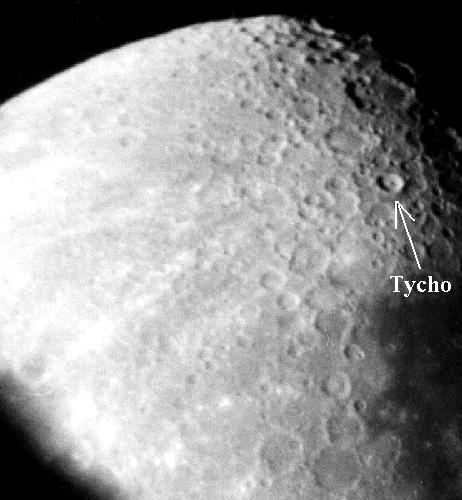Observing the Moon: Tycho
Jack Kramer
The crater Tycho is one of the most prominent objects on the moon...and yet it's not. This contradiction stems from the geometry of this very young crater. When the moon is full, Tycho stands out as a bright beacon, and its system of rays can be traced far across the lunar surface. At 56 miles in diameter, it's not among the largest of craters; however, it's an abyss 13,800 feet deep surrounded by walls 13 miles thick. A central peak also stands out prominently. When viewed near the terminator, Tycho is all but lost in the jumble of other craters in a region referred to as the "Southern Highlands" of the moon. The reason for this is that its outside walls do not rise any higher than those of surrounding features. As a result, its exterior contours simply don't stand out under a low angle of illumination.
I took the following photo 17 years ago through an 8-inch reflector when the moon was in a gibbous phase. In this orientation, Tycho is the most prominent medium-sized crater near the right edge of the image. Because of its great depth, it stands out primarily due to the combination of light and shadow on its interior walls.

The photograph also shows well the rays caused by the ejecta spewed out at the time of the impact that formed Tycho. (Hopefully, the printed image shows some of the detail of the original photo.) While these rays don't stand out well around first or last quarter phases, they become very prominent as the moon nears full. It is this ray system which most strongly supports the impact theory of Tycho's origin, and the origin of other craters as well.
The lunar robotic vehicle Surveyor 7 landed on the outer slope of Tycho in January 1968. By the time the sun had set two weeks after landing, Surveyor had transmitted to Earth about 21,000 images of the rugged surroundings. Info on this mission and images are available at the URL:
http://nssdc.gsfc.nasa.gov/nmc/masterCatalog.do?sc=1968-001A
Finally, the sharp-eyed British observer, Thomas Webb, called attention to the fact that Tycho is visible to the naked eye at full moon. It should appear as a small bright spot. Although I've tried several times, I have not been able to see it naked eye. Care to test your eyesight?
Published in the January 2000 issue of the NightTimes




